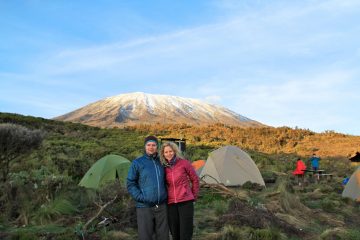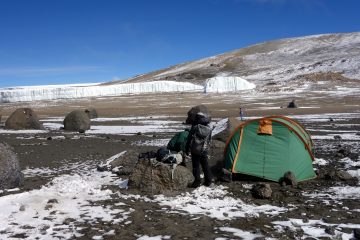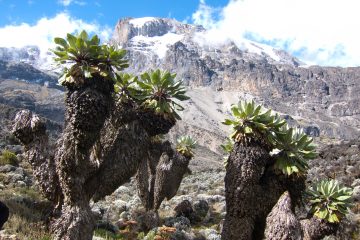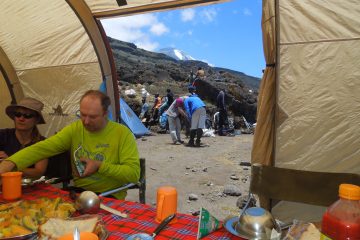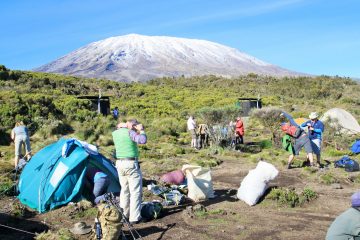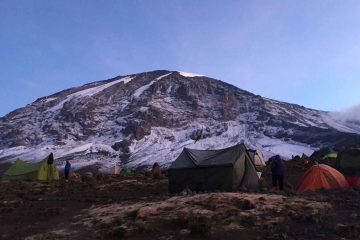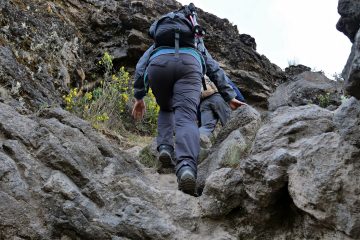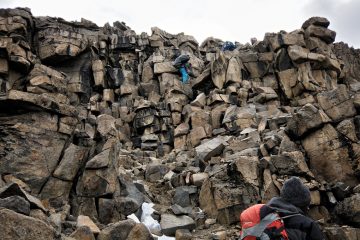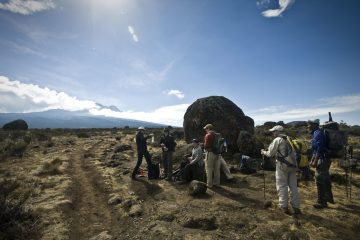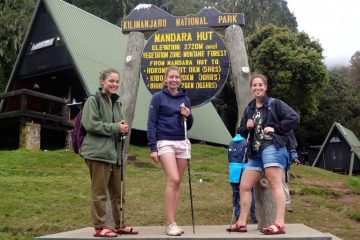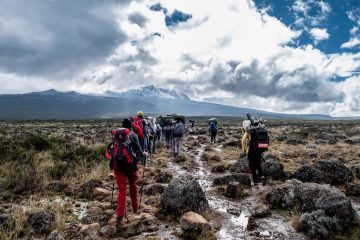The Kilimanjaro National Park and park fees fall under the regulation of the Kilimanjaro National Park Authority (KINAPA). It is this same government body that dictates the park fees which reflect on your mountain climbing costs among other fees like government taxes and logistic fees. The Kilimanjaro national park rule dictates that for one to climb Mount Kilimanjaro, one must pay the park fees for Kilimanjaro, you must have a mountain guide, choose a designated route and a safe one at least, and must use a licensed tour operator, this is where Tranquil Kilimanjaro comes in.
Mount Kilimanjaro Park fees
Paying park fees to enter the Kilimanjaro National Park and begin your actual climb is a mandatory requirement. Many are stunned to discover how much it costs to climb Kilimanjaro (spoiler alert: the price varies depending on the route, party size, and operator, but it typically costs between $1500 and $3000). Read about how much it costs to climb Mount Kilimanjaro.
The Mount Kilimanjaro National Park entrance fees, which are determined by KINAPA (the Kilimanjaro National Park Authority) and are an obligatory expense to enter the park, are primarily to blame for the high price.
Since park costs make up between 50 and 70 percent of the overall climbing expense, I felt it would be beneficial to clarify how they operate, what factors go into determining park fees, and what reductions are available.![]()
What costs are included in Kilimanjaro Park Fees?
You may see the most recent Kilimanjaro National Park admission prices here for 2023-2024. The park fees put online by the Kilimanjaro National Park Authority may be subject to change in the upcoming years of 2025-2026 or anytime there is an update.
There are six main parts that contribute to the total summation of these the park fees for hiking Mount Kilimanjaro, and they are.
Conservation fees
The National Park is protected, maintained, and supported by the conservation fee. Every day that a trekker is inside the park, they must pay a fee of US$70 per day per person. For instance, the cost of a 7-day Machame Route climb would be $490 (7 x $70 each day).
Camping fees
All other Kilimanjaro routes use public campsites, with the exception of the Marangu route’s hut accommodations. it is only the Marangu route that uses dormitory styles and A-shaped huts for accommodation on the mountain. See the Marangu huts accommodation here.
Kilimanjaro’s campgrounds are maintained and cared for by the Kilimanjaro National Park Authority, which levies a daily camping fee of $50 per hiker each night spent there.
Normally climbs are done by groups ranging from 15 climbers or less, it could also be two people or even solo climbers but they must be accompanied by a mountain expedition crew that includes, porters, guides, and their assistants, and of course cooks/chefs.
Each climber is assigned a number of porters, at least 2 or 3 or even more. The porters’ work is to assist in carrying essential items and mountain equipment like portable/private toilets, sleeping tents, tables, and mess tents.
I know you are wondering what Kilimanjaro national park says about the age limit and what other rules are on the mountain.
Following the example from before, a hiker on the seven-day Machame would spend six nights camping, resulting in a $300 camping cost (6 x $50 each night).
Hut fees
Hikers exclusively using the Marangu route are subject to the hut costs. The National Park is responsible for maintaining the huts at the Mandara, Horombo, and Kibo campgrounds, much like the campsites are. The cost is $60 per trekker per night. Therefore, a hiker would spend $300 overall on a 6-day Marangu (5 nights x $60).
Rescue Fees
Rescue fees on the mountain are also mandatory for your safety. Whether you require assistance and rescue or not, the National Park will charge you a fee. Each journey costs $20 per person.
Crater Camping fees
Only hikers who intend to camp inside the crater of Kilimanjaro are required to pay the crater camping fee. These are fees for applying for a special permit for an overnight stay at the Crater Camp on Kibo and each trekker must pay $100 each night.
Guide and Porter Entrance Fees
For guides and porters, there is an additional admission cost to the National Park. Each trip’s cost is $2 for the support crew. This normally involves a large number of hikers, thus the expense is little.
Value added tax from the Tanzanian Government (VAT)
A Value Added Tax (VAT) of 18% that must be added to park fees was implemented by the Tanzanian government in 2016 in addition to all of these other taxes.
How can I figure out the total cost to enter Kilimanjaro Park?
Based on the route and number of days you want to ascend Kilimanjaro, it is easy to calculate the total park cost using the factors mentioned above.
Let’s examine the seven-day Lemosho route as an example. The complete park charge is:
- Conservation fee: 7 x $70 per day: $490
- Camping fee: 6 nights x $50 per night: $300
- No hut fees
- Rescue fee: $20
- No crater camp fee
We’ll disregard guide and porter entry fees costs because they depend on the size of the group and are essentially insignificant.
$820 total plus 18% VAT comes to $955.80.
Here are the Kilimanjaro park fees for the most popular routes on the mountain to save you the time of calculating all the different national park fees by each route. Note that the entrance fee for Kilimanjaro porters and guides is not included in these costs as it varies depending on the number of people climbing.
- 5 days Marangu Route = USD 719.80 per trekker
- 6 days Marangu Route = USD 873.20 per trekker
- 6 days Machame Route = USD 814.20 per trekker
- 7 days Machame Route = USD 955.80 per trekker
- 7 days Lemosho Route = USD 955.80 per trekker
- 8 days Lemosho Route = USD 1097.40 per trekker
- 6 days Rongai Route = USD 814.20 per trekker
- 7 days Rongai Route = USD 955.80 per trekker
- 6 days Umbwe Route = USD 814.20 per trekker
- 7 days Shira Route = USD 955.80 per trekker
Can I pay the park fees to the Kilimanjaro National Park Authority (KINAPA) directly?
No, only authorized tour companies may pay for your parks. All Kilimanjaro tour providers include the Park Fee in the price of their overall tours.
Is there any student or Tanzanian resident park charge discount?
Yes. Children under the age of 16, Tanzanian natives and expatriates, as well as inhabitants of East Africa, are all eligible for discounts to the National Park.
The following are the discounts:
Children/Minors under 16 years
Children from 5 to 15 pay a conservation fee of $20 per day (a $50 per day discount) and a camping cost of $10 per night (a $40 per day discount). Unfortunately, there are no discounts available for the cabin, rescue, or crater camp expenses.
Please take note that a child must be 10 years old to access Kilimanjaro National Park.
Residents and expatriates from Tanzania
Residents of Tanzania and expatriates residing there pay a conservation charge of $35 per day instead of the normal $100. Camping, hut, and rescue expenses are all non-discountable.
East African citizens
Tanzanians, Kenyans, Ugandans, Burundians, Rwandans, and South Sudanese nationals receive large reductions on all costs (up to 90% savings). You do not need to be a resident of these nations to enter, but you will need to show a current passport. The EAC discount is shown here.
Kilimanjaro National Park Fees
| Entry Permit Fee for Kilimanjaro National Park per person, per day | |
| a) Of or above the age of 16 years | 60 USD |
| b) Kids Between the age of 5 years and 16 years | 10 USD |
| c) Children below the age of 5 years | Free |
| Camping Permit in Kilimanjaro National Park per person, per day | |
| a) Of or above the age of 16 years | 60 USD |
| b) Kids Between the age of 5 years and 16 years | 10 USD |
| c) Children below the age of 5 years | Free |
| Huts, Hostel, Rest Houses Fees per person, per day | |
| a) Kilimanjaro National Park: Mandara, Horombo and Kibo (Huts and Camping) | 60 USD |
| Rescue Fee for Mount Kilimanjaro per trip per person The park shall be responsible for rescue between the point of the incident and the gate in any route. The climber will take care of other expenses from the gate to the hospital of their choice. | |
| a) Rescue fee | 20 USD |
| Personnel Fees per day per person | |
| a) Porters | 10 USD |
| b) Cooks | 15 USD |
| c) Guides | 20 USD |
Terms and Conditions in Kilimanjaro National ParkIt is a given condition that your safety is your responsibility within the Kilimanjaro National Park. The park’s Board of Trustees shall not be responsible for any bodily injury to any visitor that arises from a cause: or for or damage to the property of any visitor brought into the park arising from fire, theft or otherwise by whomsoever caused or arising from negligence or wrongful act of any person in the employment of the Board. All visitors are bound to have contracted with the Board on this basis. “FEES ONCE PAID SHALL NOT BE REFUNDED” | |
Where can I pay the park entrance fees to climb Mount Kilimanjaro?
Park fees are paid to the tour operator, who then uses the formal banking system set up for park fee payment to pay the government. Therefore, once you have paid the tour company in full for your climb, you may unwind and wait for them to pick you up to start your journey to the top of Africa. On Mount Kilimanjaro, climbers must pay park fees, which include crew, rescue, camping, and conservation expenses. Additionally, extra forest taxes are payable on the Lemosho and Rongai routes. It is yet another important factor in the price of climbing Mount Kilimanjaro.
Be warned that some dishonest tour providers purposefully give inaccurate information about park entrance prices. Never believe rumors that you may climb Mount Kilimanjaro without paying by avoiding ranger stations. It is just not feasible to go to Uhuru Peak without running into any park officials. Every year, dozens of people who do this are captured. On Mount Kilimanjaro, climbers must pay park fees. Additionally, it is risky. You will lose the chance to get prompt help from the rangers if you deviate from the approved routes where climbing permits are checked at each ranger post.
In Tanzania, trespassing on national parks is a severe crime. The best-case scenario involves getting deported and paying huge fines, leaving you without the chance to ever experience Tanzania’s beauties again. Additionally not to be ruled out is imprisonment. When it comes to paying the park fees, you have two choices. The most frequent and well-liked choice is to pay the trek costs and the park fees upfront to such a tour organization. VAT and park fees are included in every pricing on the website.
Another choice is to pay the park department directly for the entrance costs. At the park gate, you may do this with any Visa card.
On the first day of the climb, you would do this action at the park entrance that we would use. The customer has the choice of paying the tour company or the park department directly.
When making a reservation, be sure to specify how you plan to pay. The price to climb Kilimanjaro is between $2,000 and $3,000. But there are additional costs as well, such as airfare, visa fees, travel and health insurance, and mountain equipment that is also required since it is crucial. Many people decide to climb Kilimanjaro without fully considering the financial repercussions. The cost of climbing Mount Kilimanjaro varies greatly.
You may spend anything from $1,000 to more than $4,000 to climb Kilimanjaro. A trek up Kilimanjaro may cost anywhere from $1,400 for a base package and over $7,000 for a premium one. Making the best decision becomes a challenging issue when you consider that there are 250 legal and hundreds of unregistered businesses in the area. in order to comprehend the ascent. Choosing how much to pay a climber to climb Kilimanjaro is challenging. Be cautious not to spend more than $3,000 for each climber. Knowing what sort of trip you’re paying for, understanding what you want and expect, and asking for it from your outfitter are the keys to a successful trip.
For every three to four climbers, your operator should have a guide, an assistant guide, a chef, and three to four porters. A crew of five or six persons should be available for each climber.
The minimal costs incurred by Kilimanjaro tour operators for each customer include Daily Park and camping or hut fees, personnel salaries, meals for customers, guides, and porters, equipment, and transportation costs in addition to lodging costs. Entry fees to the Kilimanjaro National Park, camping fees, and local pay for porters and guides add up to a total of $100 per climber per day. Food expenditures average around $10 per climber per day.
The official climbing costs for Kilimanjaro National Park are already included in your operator charge.
The pay for porters, assistant porters, and guides is included in your operator charge and varies amongst trekking companies. The majority of outfitters regard the following salaries to be high, however, they pay less.
There are two payment methods for park fees.
should pay the corporation directly the park costs in addition to the trek fees. VAT and park fees are both included in all pricing on the company’s website. After then, the business will pay the park department’s fees. straight to the park service in order to pay the park fees. At the park gate, you may do this with any Visa card. At the park gate on the first day of the ascent, you would do this action.
Kilimanjaro National Park Regulations
The Kilimanjaro National Park rules and regulations guide you when climbing the mountain and staying inside the Kilimanjaro National Park itself. These regulations have been put there for your own benefit and for benefit of conserving the natural environment of the mountain, wildlife, and vegetation. These rules must be adhered to and respected as expected, failure to which stern action might be undertaken for the benefit of your own well-being and co-existence in the park.![]()
You can read and download the rules and regulations of Kilimanjaro National Park here.






